Book Post 34: 14-20 April 2019
Every week I post some of the books I have received recently. In today’s Book Post 34 included are some of the titles I have received in the past few weeks.
22 April 2019
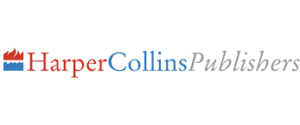 2017. A landmark year for HarperCollins worldwide. The publishing firm is celebrating its bicentennary and the Indian office is marking 25 years of its operations locally. Stories from HarperCollins Publishers ( 1817 – 2017) a succintly produced edition chronicling the firm’s history. There are fascinating nuggets in it.
2017. A landmark year for HarperCollins worldwide. The publishing firm is celebrating its bicentennary and the Indian office is marking 25 years of its operations locally. Stories from HarperCollins Publishers ( 1817 – 2017) a succintly produced edition chronicling the firm’s history. There are fascinating nuggets in it. 
HarperCollins Publishers began as J. & J. Harper, a small family printing shop run by brothers James and John Harper in New York City in March 1817. In 1825 the company posted an advertisement in the United States Literary Gazette announcing five forthcoming titles. Scotsman Thomas Nelson ( born Neilson) opened a secondhand bookshop in Edinburgh in 1798, eventually publishing inexpensive editions of noncopyrighted religious texts and popular fiction. Collins also started out as a small family-run printer and publisher. Chalmers and Collins, established by millworker and seminarian William Collins and Charles Chalmers ( brother of evangelical preacher Thomas), published its first work in 1819. It began by publishing only the writings of the Reverend Dr. Thomas Chalmers, but soon published other authors, eventually forming William Collins and Sons.
 In 1962 what was then known as Harper & Brothers merged with textbook publisher Row, Peterson & Company, forming Harper & Row. HarperCollins as a brand came into existence in 1989 after News Corporation purchased Harper & Row ( 1987) and Collins ( 1989). Today HarperCollins global brand publishes approximately 10,000 new titles every year in 17 languages and has a print and digital catalogue of more than 200,000 titles. Along the way it has acquired other well-established businesses with robust identities of their own such as 4th Estate, Angus & Robertson, Amistad Press, Avon Books, Caedmon Audio, Ecco Press, Funk & Wagnalls, Granada, Harlequin, J.B. Lippincott, the John Day Company, Thomas Y. Cromwell Co., Thorson’s, Unwin Hyman, William Morror and Company, Zondervan, HarperCollins Christian Publishing and others. Many of these remain as imprints of HarperCollins.
In 1962 what was then known as Harper & Brothers merged with textbook publisher Row, Peterson & Company, forming Harper & Row. HarperCollins as a brand came into existence in 1989 after News Corporation purchased Harper & Row ( 1987) and Collins ( 1989). Today HarperCollins global brand publishes approximately 10,000 new titles every year in 17 languages and has a print and digital catalogue of more than 200,000 titles. Along the way it has acquired other well-established businesses with robust identities of their own such as 4th Estate, Angus & Robertson, Amistad Press, Avon Books, Caedmon Audio, Ecco Press, Funk & Wagnalls, Granada, Harlequin, J.B. Lippincott, the John Day Company, Thomas Y. Cromwell Co., Thorson’s, Unwin Hyman, William Morror and Company, Zondervan, HarperCollins Christian Publishing and others. Many of these remain as imprints of HarperCollins.
Over the years it established credibility as being an author’s publisher for it protected rights and fought against piracy. In the 1800s Harper brothers ensured that they were fair in paying royalties to their authors, particularly those who were overseas. Their fiercest competitor was Mathew Carey’s publishing house of Philadelphia. A cease-fire between the rivalry happened in 1830s and “The Harper Rule” agreement was reached. According to Stories from HarperCollins Publishers “in [this] a publisher would cease printing when a competitor purchased advance proofs and announced forthcoming titles, or had previously published a British author.” This enabled the Harper brothers to invest more in finding and developing relationships with authors. They also began to explore other markets in the 1800s such as Canada, Australia and India. Interestingly they broke into new markets with texts such as prayer books, geography, gospels, dictionaries, schoolbooks, readers and primers.

Poet Gulzar and veteran Bollywood actress-turned-politician Hema Malini cutting the HarperCollins 25th anniversary cake, New Delhi, July 2017.
The stable of authors associated with HarperCollins is extraordinary. The firm published the American edition of Walter Scott’s Peveril of the Peak ( 1823), Edward Lytton Bulwer’s The Coming Race ( 1871), and H. G. Wells’s The War of the Worlds ( 1898) and The Invisible Man ( 1898). These were deemed as “scientific romance”. Later with the acquisition of Unwin Hyman by Collins the firm discovered the winning formula of fantasy worlds furnished with maps and illustrations as has been proved with the success of J. R. R. Tolkien’s The Hobbit ( 1937) and The Lord of the Rings trilogy ( 1954 – 55). Other writers include ( listed in no specific order) C. S. Lewis, Paulo Coelho, Deepak Chopra, Erle Stanley Gardner, Aldous Huxley, Herman Melville, Harper Lee, Gabriel Garcia Marquez, John Gray’s Men are from Mars, Women are from Venus, George R. R. Martin, Harriet Beecher Stowe, Agatha Christie, Laura Ingalls Wilder, Sylvia Plath, Pearl Buck, Doris Lessing, Frances Hodgson Burnett, Martin Luther King Jr., Maurice Sendak, Shel Silverstein, E. B. White, Michael Bond’s Paddington Bear, Judith Kerr, Armistead Maupin, Alan Cummings, Caitlin Moran and Roxane Gay.
In the 1800s the publisher made exploratory trips to India too and witnessed an explosion in fiction writing in the 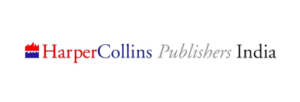 1890s due to high population density coupled with growing literacy. In 1992 HarperCollins establish a base in India when it entered into a partnership with the Indian firm, Rupa Publications. After a few years a new collaboration was forged with the India Today group. Finally HarperCollins became an independent entity of its own and its headquartered in Delhi NCR. The CEO is Ananth Padmanabhan.
1890s due to high population density coupled with growing literacy. In 1992 HarperCollins establish a base in India when it entered into a partnership with the Indian firm, Rupa Publications. After a few years a new collaboration was forged with the India Today group. Finally HarperCollins became an independent entity of its own and its headquartered in Delhi NCR. The CEO is Ananth Padmanabhan.
To celebrate 25 years of its impressive presence in India, HarperCollins India ( HCI) has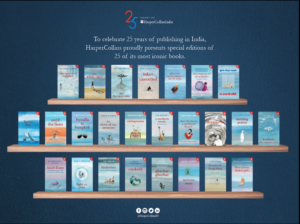 launched a campaign that consists of special editions of 25 of its iconic books and short films promoting storytelling and books. This list includes writers such as Anuja Chauhan, Anita Nair, Kiran Nagarkar, Rana Dasgupta, Siddharth Mukherjee, Satyajit Ray, Akshaya Mukul, Vivek Shanbhag, B. K. S. Iyengar, Arun Shourie etc. HCI has also launched a scrumptious
launched a campaign that consists of special editions of 25 of its iconic books and short films promoting storytelling and books. This list includes writers such as Anuja Chauhan, Anita Nair, Kiran Nagarkar, Rana Dasgupta, Siddharth Mukherjee, Satyajit Ray, Akshaya Mukul, Vivek Shanbhag, B. K. S. Iyengar, Arun Shourie etc. HCI has also launched a scrumptious 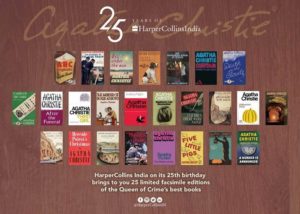 list consisting of 25 facsimile editions of Agatha Christie novels.
list consisting of 25 facsimile editions of Agatha Christie novels.
Happy Birthday, HarperCollins!
2 August 2017
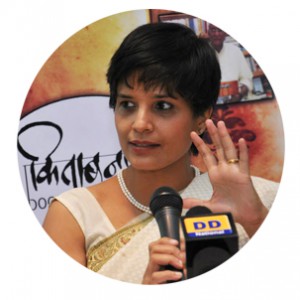 My monthly column, Literati, in the Hindu Literary Review was published online ( 18 July 2015) and was in print ( 19 July 2015). Here is the http://www.thehindu.com/books/literary-review/jaya-bhattacharji-rose-on-the-world-of-books/article7429521.ece. I am also c&p the text below.
My monthly column, Literati, in the Hindu Literary Review was published online ( 18 July 2015) and was in print ( 19 July 2015). Here is the http://www.thehindu.com/books/literary-review/jaya-bhattacharji-rose-on-the-world-of-books/article7429521.ece. I am also c&p the text below.
In a column on January 11, 2015, The New York Times published Michiko Kakutani’s review of Harper Lee’s much-awaited Go Set A Watchman(@GSAWatchmanBook ) — on the front page, no less. There have been energetic nitpicking conversations about this review. But the truth is that any space given by a mainstream newspaper to a book review is unusual. For, despite the 50-year gap between To Kill a Mockingbird and Go Set A Watchman, the latter has a two million print run. Lee’s resurrection of Atticus Finch has excited readers. According to Bloomberg, US, “it is the most pre-ordered book in her publisher’s history.” (July 9, 2015, http://bloom.bg/1HXxgij )
This pre-publication hype is any writer’s publicity dream. Space for reviewing books in print media is fast dwindling while rapidly gaining momentum on social media, prompting many writers to be creative in getting their books discovered. Popular writer, Ravi Subramanian has launched an app to help promote his books. Booksellers too have to be innovative — curating literary engagements or as the portly owner of Haji Suleiman and Sons tells Hafiz in Anis Shivani’s lengthy debut novel, Karachi Raj “Shelving is an art. Mixing the old and the new on the same subject is more important than getting the alphabetical order just right.”
An important part of the publishing ecosystem is the critic. The few well-read critics like James Wood, Amitava Kumar, Tim Parks and John Freeman are known and greatly valued for their honest, straightforward and informed observations. Whether in print or virtual space, by critics or others (publishing professionals use their Facebook walls to air frank opinions), a good review should generate conversation. Recently, Daniel Menaker — writer and former Editor-in-Chief, Random House Publishing Group — said of the new Harper Lee novel : “Here’s the thing: it is natural and inevitable for readers and experts to compare these two Harper Lee books to each other. But the comparisons have absolutely nothing to do with the quality of each book. They are two different objects. You can get historical perspective about an artist by comparing an early landscape to a late one, but the value of both remains entirely independent of their relation to each other. Rembrandt’s series of self-portraits is an excellent source of historical, biographical comparison, but as works of art they must be judged on their own merits. [Alexander] Alter’s piece in The Times is where it should be — outside the review arena. Kakutani’s “review” should have given no more than a nod to TKAM in discussing GSAW, if you ask me. The rest of the review would have been actually more useful if it had addressed the merits and problems with GSAW on its own terms. Seems to me.” (Quote reproduced with permission.)
With this, Menakar sparked off a crackling literary conversation about the merits of reviewing. To be a professional critic is never painless. It is particularly tough when the critic is an integral part of the literary set of concerned editors, publishers and authors; some of whom have acquired demi-god status. Thus Shamsar Rahman Faruqui’s The Mirror of Beauty and The Sun that Rose from the Earth, and Amitav Ghosh’s Flood of Fire, which are rich longwinded tapestries of the past, have had reasonably good sales and glowing critical acclaim. In his Afterword to Mantonama, Saadat Hasan Manto declares: “know-it-all pundits” can have a powerful impact on an author, but solace lies in realising that “literature…is a self-existent entity. …Literature is as alive and exuberant today as it was before it was discovered.” (My Name is Radha: The Essential Manto, translated by Muhammad Umar Memon.)
In ‘Bad News’, an essay in his splendid book, Lunch with a Bigot, Amitava Kumar sums it: “With all their beauty and artifice, novels often hide the ordinary grit of reality. …It is the irrepressible bubbling-up of the everyday, not the unbending demand of a rigid aesthetic, that makes a novel satisfying, that connects it to life.” Saikat Mazumdar’s exquisite The Firebird and K. R. Meera’s disturbing novella And Slowly Forgetting that Tree (translated from Malayalam by J. Devika) are fine examples of such satisfying literature.
15 August 2015
 Random House is delighted to announce that 54 years after it was first published Harper Lee’s To Kill a Mockingbirdwill be released as an ebook today for the first time.
Random House is delighted to announce that 54 years after it was first published Harper Lee’s To Kill a Mockingbirdwill be released as an ebook today for the first time.
This Pulitzer Prize-winning novel has been translated into more than 40 languages, and sells well over 1 million copies each year worldwide. Now, for the first time, To Kill a Mockingbird will be available as a straight text ebook, an enhanced ebook with extra exclusive content, and a digital audio, narrated by Oscar-winning actress Sissy Spacek.
‘I am amazed and humbled that Mockingbird has survived this long,’ said Nelle Harper Lee. ‘I’m still old fashioned. I love dusty old books and libraries. This is Mockingbird for a new generation.’
The ebook is available with all ebook retailers including Flipkart, Amazon, Google Play and Kobo.
8 July 2014
Caroline Newbury
VP Marketing and Corporate Communications
Random House India
Penguin Random House
7th Floor, Infinity Tower – C
DLF Cyber City, Gurgaon 122002, Haryana
P +91 124 4785600
F + 91 124 4785606